Panasonic Viera TX-37LZD70 37in LCD TV Review
Panasonic Viera TX-37LZD70 37in LCD TV
Panasonic ups the ceiling on its LCD TVs with this 37in Full HD model.
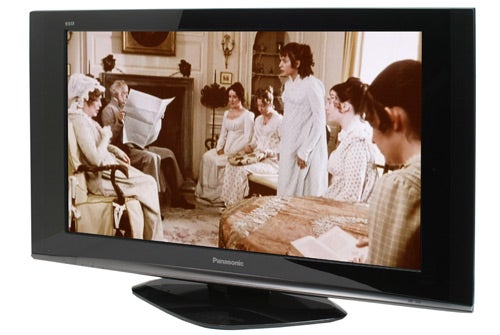
Verdict
Key Specifications
- Review Price: £859.00
Despite the fact that Panasonic is best known for its excellent plasma TVs, the company also does a nice line in LCD screens too. However, Panasonic does things differently from other TV manufacturers, drawing a definite distinction between its LCD and plasma ranges. Panasonic has always insisted that LCD is good for screen sizes up to 32in, but above that plasma is the better option – until now, that is.
The Viera TX-37LZD70 heralds a departure from Panasonic’s previous stance, in that it’s a 37in LCD TV. There’s a very good reason why Panasonic has upped the maximum screen size for its LCD TVs, and that reason is Full HD. Back in July I reviewed the Panasonic TH-42PZ700B and marvelled at the fact that Panasonic had managed to shrink its plasma chambers enough to squeeze a 1,920 x 1,080 Full HD resolution into a 42in screen. As such, the chances of seeing a 37in Full HD plasma are pretty slim for a while – hence Panasonic’s decision to release a 37in Full HD LCD TV to bridge the gap.
I’ve given the game away fairly early on, and you now know that this is a Full HD, 1080p screen – which is fast becoming the standard when it comes to good quality HDTVs. This means that the TX-37LZD70 has a native resolution of 1,920 x 1,080 and will happily accept a progressive signal from a source device at that resolution. Unfortunately, it’s this set’s 1080p ability that lets it down somewhat, compared to its direct competition. First up, like previous Panasonic Full HD TVs I’ve looked at, this one will only accept a 1080p signal through HDMI, so if you have an older Xbox 360, you won’t be able to set the output to 1080p. Obviously, the newer consoles come with HDMI support, but there are a lot of X360s out there with only component video output.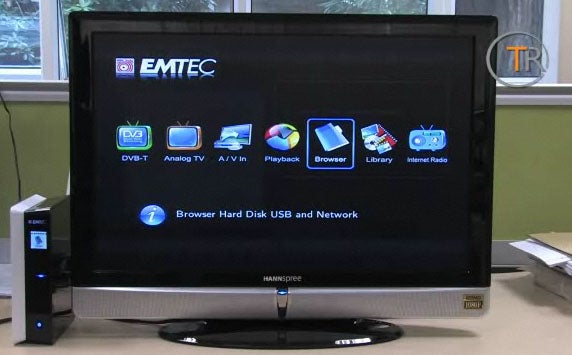
The second issue is far more concerning – this TV doesn’t support a 1080p 24Hz input. Now, when Panasonic first told me about its Full HD TV line up at the beginning of the year, I was mildly concerned about the lack of 1080p 24Hz support, since there wasn’t much in the way of source devices at the time. However, there’s now no shortage of high definition players that will output a 1080p source at 24 frames per second, making the fact that this TV doesn’t support it quite concerning, especially since it’s such a new model. This situation is exacerbated by the fact that pretty much every other Full HD TV we’ve looked at lately features 1080p 24Hz support.
Connection wise the TX-37LZD70 is pretty much par for the course. You get two HDMI ports for digital high definition sources, as well as component video jacks for analogue HD devices, like the aforementioned Xbox 360. Also on offer are two SCART sockets, a D-SUB PC input, S-Video and composite video inputs – anyone who uses the latter on a TV like this deserves to be shot! You also get a CI slot for adding subscription services to the built-in Freeview tuner, while an SD card slot (SDHC compliant) lets you view your digital photos straight out of your camera.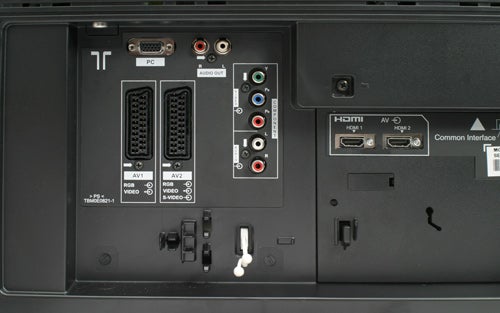
You also get analogue audio outputs, but disappointingly there’s no digital audio output. This means that you won’t be able to pass through a digital audio stream to an external processor or receiver, since any HDMI sources will be sending the digital audio bit-stream to the TV. It also means that if any terrestrial digital channels start broadcasting Dolby Digital soundtracks, you won’t be able to pump them through to your surround sound system either. This isn’t the sort of omission I would expect on Panasonic’s top of the range LCD TV, especially since the 32in, non-1080p Panasonic TX-32LXD700 does feature a digital audio out.
Another feature that’s missing from the TX-37LZD70 is 100Hz processing, something that again is present on the excellent TX-32LXD700. Of course this probably means that we’ll see a TX-37LZD700 at some point with all those features and three HDMI ports.
Panasonic quotes a contrast ratio of 8500:1, but this will come courtesy of a dynamic backlight, rather than the truly amazing contrast ratios that are offered by the latest crop of plasma screens. That said, you don’t get the annoying brightness shift that plagues some TVs with dynamic backlight control, although the black levels aren’t what I’d call class leading. There’s also a hint of backlight bleed at the bottom of the screen when watching a widescreen movie. Of course you can negate this by zooming the image, but that’s not a practice I would ever recommend.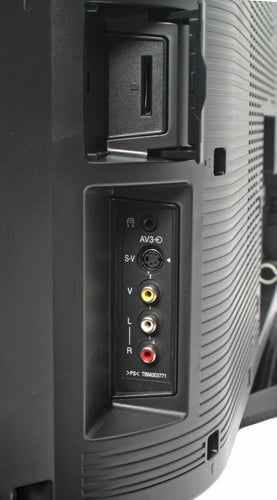
When it comes to sharpness and fine detail though, the TX-37LZD70 excels. The desert shootout in the HD DVD of Transformers was truly awesome, with every grain of sand and every wisp of smoke beautifully rendered. Even with the scorchingly bright desert sun beating down on the white buildings and sand, you could easily pick out fine detail in bright areas of the scene.
The Matrix Trilogy on HD DVD looked just as impressive, with the TX-37LZD70 having no problem keeping up with the fast paced fight scenes, or the freeway chase in The Matrix Reloaded. Of course the Toshiba HD-XE1 was capped at 1080p, rather than its top end 1080p 24Hz output, but nonetheless, the pictures produced by the TX-37LZD70 were crisp and clear.
Firing up Mass Effect on the Xbox 360, the TX-37LZD70 showed that it has no problem dealing with bright, vivid colour palettes, while the superb detail resolution really showed off the game’s ground breaking facial animation to great effect. The TX-37LZD70 also had no problem keeping up with the lightning fast pace of Pro Evolution Soccer 2008, giving the game a lifelike and immersive feel – England beat Croatia 2:0 during testing!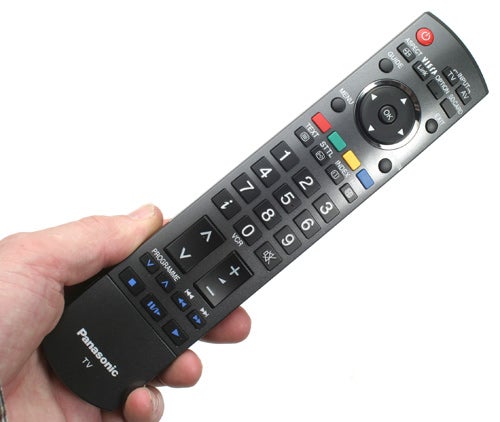
Panasonic hasn’t forgotten about standard definition either, and despite the 1,920 x 1,080 native panel resolution, the TX-37LZD70 produced some very impressive SD pictures, even from its built-in digital tuner. In fact, even with some of the horrible, low bit rate channels that you can find on Freeview, this TV managed to produce a watchable image, with as little blocking as can be reasonably expected.
Visually the TX-37LZD70 looks like a larger version of Panasonic’s other LCD screens. Unfortunately this means that it has side mounted speakers, rather than under mounted. This makes the TX-37LZD70 over ten centimetres wider than Panasonic’s TH-37PX70 plasma TV, which also sports a 37in panel – a very odd design decision, considering that most consumers look at a 37in TV because their room can’t accommodate anything larger.
In defence of Panasonic’s design department, the sound quality from the side mounted speakers is pretty good. There’s a good level of clarity, a reasonably wide sound stage and even a good stab at directional effects. Obviously you’re still not going to get the kind of bass effects that you’d get from a dedicated sound system, but even when it comes to low frequency fodder, the TX-37LZD70 is above average.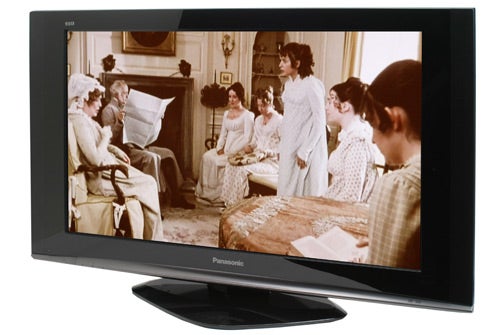
Price wise, the TX-37LZD70 looks good at £859, but only in isolation. When you consider that the excellent Toshiba 42X3030D can be had for under £800, the Panasonic starts to look somewhat expensive – especially when you consider that the Toshiba is a 42in set, supports 1080p 24Hz and is happy to receive a 1080p signal via its component video input. In fact, if I absolutely had to have a 37in TV I’d rather have Panasonic’s TH-37PX70 plasma – it may not be full HD, but it’s smaller, better looking and is a steal at around £700.
”’Verdict”’
I can understand why Panasonic has decided to come to market with a 37in Full HD LCD TV, but unfortunately the TX-37LZD70 lacks some of the key features sported by its competitors. The lack of 1080p 24Hz may have been acceptable six months ago, but these days, with plenty of HD players offering pure 24fps output, this Panasonic looks to be behind the times. Add to this Panasonic’s continued insistence to not let its TVs accept a 1080p signal through component video, and it’s hard to recommend the TX-37LZD70.
The above issues are a real shame, because the pictures produced by the TX-37LZD70 are generally very good, whether viewing HD or SD content, and the sound is above average for a flat screen TV. Ultimately though, if you have between £800 and £900 to spend on a Full HD TV, my suggestion would be to go for the Toshiba 42X3030D instead.
How we test televisions
We test every TV we review thoroughly over an extended period of time. We use industry standard tests to compare features properly. We’ll always tell you what we find. We never, ever, accept money to review a product.
Trusted Score
Score in detail
-
Value 7
-
Image Quality 9
-
Sound Quality 8

